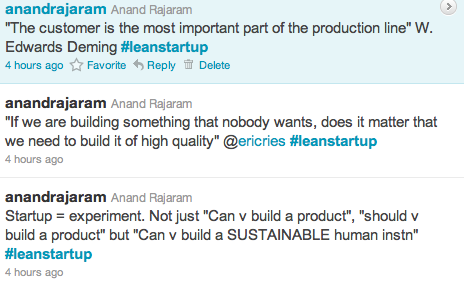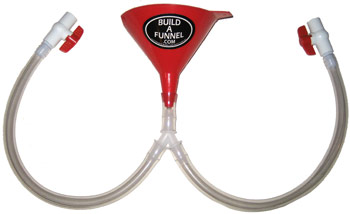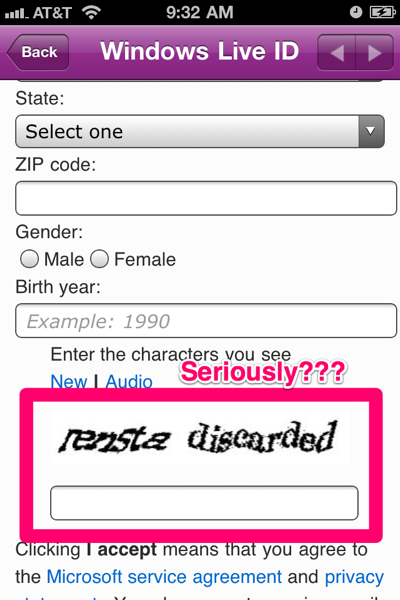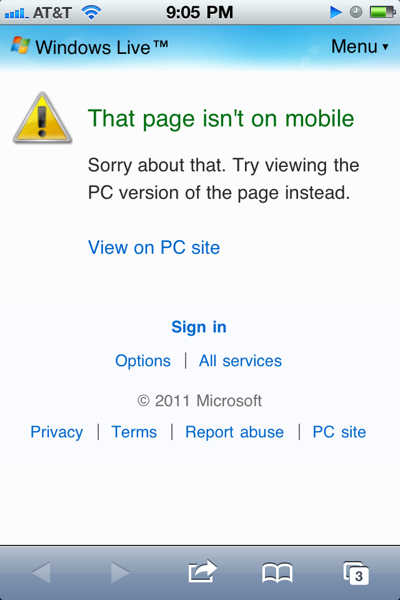Notes from Lean Startup Circle Boston Jan 2011 Meetup - Part 1
Lean Startup Jan Meetup was exciting, thanks to a presentation by Eric Ries. Thanks to HBS and their course on Entrepreneurial Management, I am hoping Eric will be around town more often, and we get to pick his brains on all kinds of interesting things on Lean Startups. The original announcement promised to go “Beyond methodology”. I felt like Eric couldn’t get to a lot of the ”new material” until the end, which was a bummer, but the Q & A session made up for that in some ways.
This is Part 1 of my notes from the session (some of them are recaps, all the way back to #sllconf last year). Stay tuned for Part 2 over the weekend.
-
The Unit of progress in a startup cannot be that of ”advancing to the next stage”. That way of looking at things, is mostly based on three “Shadow Beliefs” :
-
We know what customers want
-
We can actually predict the future
-
Advancing the plan is “progress”
-
Instead, the more appropriate unit of progress in a Startup is ”Validated Learning”. In effect, your startup’s success depends on how many times you can go through the “Build -> Measure -> Learn” loop, and you maximize the number of times through the loop, by optimizing through the ENTIRE LOOP and not just a specific part of it.
-
When you are in a startup, you no longer have a functional discipline. You are not a programmer, not a marketer, you should do whatever is needed at that moment. Personally, I am a big believer in this idea, and this is one big part of what motivates me to start / work for a startup. I have had intense discussions on term sheets, design and send email marketing, hack a script to do cohort analysis, figure out a weird issue with “phrase search” in our search engine and be on phone-support and live-chat support, all in the same week.
-
Insert Customary slide about pivot being the “P-word” and funny NewYorker cartoon :

-
Now it gets interesting. Eric crystallized Lean startups into 5 important principles:
-
Entrepreneurs are everywhere : In effect, wherever there is uncertainty, there is entrepreneurship. This is a bit of a blue-sky, mom-and-apple-pie notion, but I’ll play along. Every earth shattering idea is something simple at its core and this could be one such core of Lean Startups. The larger point is that Lean Principles need not be applicable only to startups, they can as well be applied to other contexts.
-
Entrepreneurship IS management : Entrepreneurial management is a peer-level to the more traditional MBA-like General Management. One is not better than the other, they are just different. General Management focuses on processes, efficiencies, scale while Entrepreneurial Management focuses on trying to find a sustainable business model.
-
Validated Learning: See notes above
-
Build - Measure - Learn: Refer to the Kent Beck session notes from my earlier blog post from #sllconf 2010
-
Innovation Accounting: It is essential for a startup to focus on actionable data, and not on vanity metrics. Metrics that always go up and to the right (such as Cumulative total accounts) don’t matter. Metrics that reflect random environmental events, press releases (such as Pageviews) don’t matter. Metrics that focus on Per customer engagement are very important. How many times have users logged in? How many people have they referred? (#aarrr). Eric’s point was that we need an accounting paradigm that lets entrepreneurs communicate quantitatively what they have done by way of validated learning. This kind of a paradigm will be helpful when raising money. (I really like this term, and I hope it doesn’t get abused and overused like Pivot was)
-
And here are the soundbites from my twitter stream during the event :

Did you attend the event? What did you get out of it? Stay tuned for Part 2, for some of the questions that every lean startup faces and how to head in the right direction when faced with those questions.
** **
 .
.




 Update : This seems to have been fixed by now)
Update : This seems to have been fixed by now)